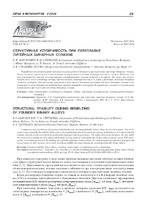Структурная устойчивость при переплавке литейных бинарных сплавов

Date
2024Publisher
Another Title
Structural stability during remelting of foundry binary alloys
Bibliographic entry
Марукович, Е. И. Структурная устойчивость при переплавке литейных бинарных сплавов = Structural stability during remelting of foundry binary alloys / Е. И. Марукович, В. Ю. Стеценко, А. В. Стеценко // Литье и металлургия. – 2024. – № 2. – С. 29-31.
Abstract
Разработан наноструктурный механизм структурной устойчивости при переплавке литейных бинарных сплавов. Этот механизм определяется устойчивостью центров кристаллизации микрокристаллов α- и β-фаз. Показано, что эта устойчивость зависит от концентрации адсорбированных атомов водорода и кислорода. Чем выше эти концентрации, тем менее устойчивы центры кристаллизации микрокристаллов α- и β-фаз в расплавах литейных бинарных сплавов и наоборот. При увеличении перегревов и (или) времен выдержки расплавов литейных бинарных сплавов в них повышаются концентрации адсорбированных атомов водорода и кислорода. В результате снижается структурная устойчивость при переплавке литейных бинарных сплавов.
Abstract in another language
A nanostructural mechanism of structural stability during remelting of foundry binary alloys has been developed. This mechanism is determined by the stability of the centers of crystallization of microcrystals of α-phases and β-phases. It is shown that this stability depends on the concentration of adsorbed hydrogen and oxygen atoms. The higher these concentrations, the less stable the centers of crystallization of α-phase and β-phase microcrystals in melts of foundry binary alloys, and vice versa. With an increase in overheating and (or) the holding time of melts of foundry binary alloys, the concentrations of adsorbed hydrogen and oxygen atoms in them increase. As a result, structural stability decreases during the remelting of foundry binary alloys.
View/
Collections
- № 2[26]
